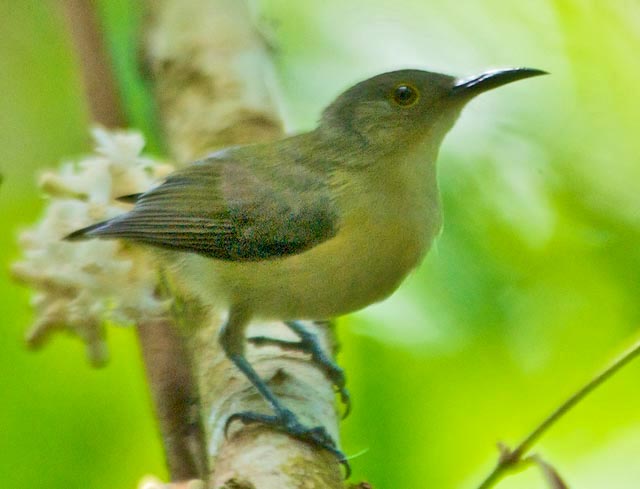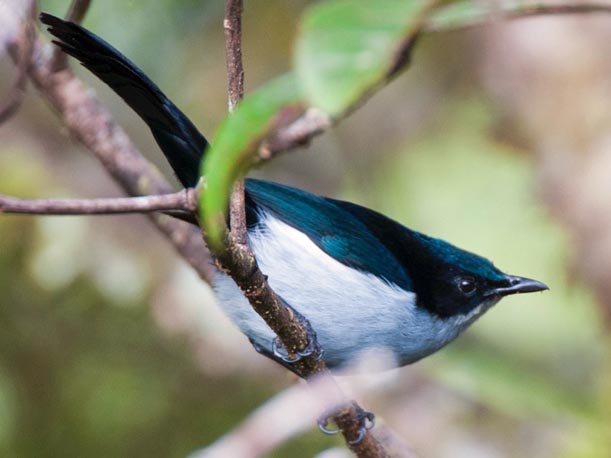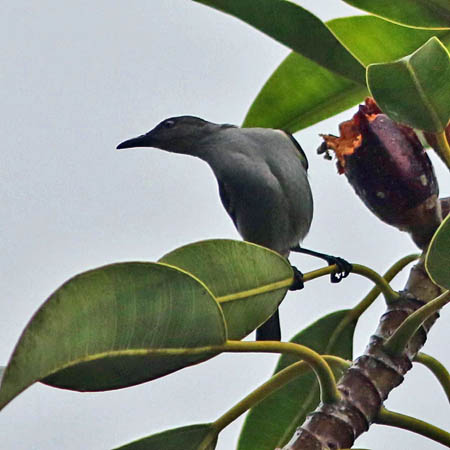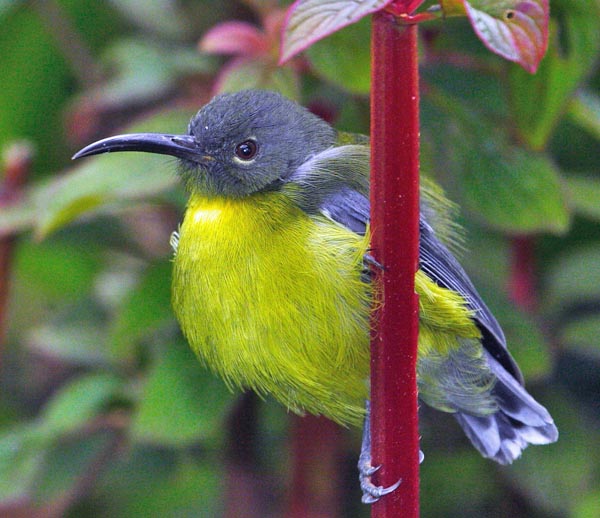
a web page by Don Roberson |
BERRYPECKERS & LONGBILLS Melanocharitidae |
||
|
||
This is a male Fan-tailed Berrypecker (left, a snazzy shot by David Bishop). Fan-tailed and Mid-mountain Melanocharis longicauda show white at the base of the tail. The white can be quite flashy in either sex when the graduated tail is fanned (Pratt & Beehler 2015).We can't see the white tail patches in this view but it is certainly the most colorful of the berrypeckers. Fan-tailed, Mid-mountain, and Black M. nigra are fairly common and essentially replace each other elevationally in the main mountainous spine of New Guinea.
|
||
|
||
Streaked Berrypecker Melanocharis striativentris and Spotted Berrypecker are rare species in mid-mountain forests, and may be nomadic. Rather little is known about them. Recently, however, a pair of Spotted Berrypecker (female and male both shown above) have been frequenting a small fruiting tree at Ambua Lodge at 6500' elevation [1980m] in Papua New Guinea. It is the female (above left) that is spotted and thus quite distinctive; the male (above right) is recalls females of other berrypeckers — gray below, dark olive above — except that it has a long, blunt-tipped bill. Obscure Berrypecker Melanocharis arfakiana is one of New Guinea's rarest species, isolated in very fragmented patches of forest, in some of which (i.e., the Arfak Mts.) it has not been seen its original discovery. Pratt & Beehler (2015) write: "Whether this species existed was at one time in doubt, but recent sightings and collected specimens have revealed the bird in life." Berrypeckers were traditionally placed with the flowerpeckers [family Dicaeidae] but ever since the DNA-DNA hybridization studies of Sibley & Ahlquist (1990) they have been moved to within the Corvoid assemblage. All of them do build small, compact, cup-shaped nests that are carefully woven and lined with plant material of lichen (Pratt & Beehler 2015). The most recent molecular evidence (Schodde & Christidis 2014) now suggests that the longbills are a sister group to the berrypeckers, "yet still deeply divergent from them and one another. Accordingly, we place them here in separate subfamilies within the Melanocharitidae, noting that their depths of DNA, morphological and behavioral divergence may be found to qualify them of family ranking in the future." |
||
Shown to the left is Slaty-chinned Longbill (excellent photo by Adam Riley), of the tube-tongued longbills, and below is Dwarf Longbill (fine shot by David Bishop), of the plumed longbills. Both are very small birds with decurved bills that feed on nectar, but they intake it in different ways. The two longbills in genus Toxorhamphus [Slaty-chinned and Yellow-bellied T. novaeguineae] acquire nectar through capillary action of a brush-tipped tongue that is a slender tube. In contrast, the two longbills in genus Oedistoma [Dwarf and Pygmy O. pygmaeum] have brush-tipped tongues fitted for nectar-mopping. |
||
 |
||
Genetically, these four longbills are within the corvoid assemblage but have a history of prior assignment to others families. The tube-tongued longbills were once thought to be related to sunbirds and spiderhunters (which they physically resembled) while the plumed longbills were once thought to be honeyeaters. The plumed longbills (genus Oedistoma) have "plumed flanks and discolorous yellowish-white pectorial tufts at the sides of the breast under the wings" but these are rarely seen. These are nervous and acrobatic little birds in the mid-to-upper canopy, "flying swiftly and directly between sites and calling with repeated tweeting in flight; apparently monogamous" (Schodde & Christidis 2014). The take-home message for world birders from all of this is that it is wisest to try to see at least one berrypecker and examples of each subfamily of longbill. It is possible that someday in the future this one family could become three families. |
||
Photos: David Bishop also photographed the male Fan-tailed Berrypecker Melanocharis versteri at Kumul Lodge, Papua New Guinea. Both the male and female Spotted Berrypecker Rhamphocharis crassirostris were at Ambua Lodge, near Tari, Papua New Guinea, in Sep 2016. The Slaty-chinned Longbill Toxorhamphus poliopterus was photographed by Adam Riley in Papua New Guinea. The Dwarf Longbill Oedistoma iliolophus was photographed by David Bishop at Varirata NP, Papua New Guinea. Bibliographic note: There is no "family book" covering the Melanocharitidae, but the family is very well chronicled, with art and photos, in Gregory (2008). Literature cited:
|
 The
Melanocharitidae are a family of small passerines endemic to New
Guinea, comprised of six berrypeckers and four longbills. The six
species of berrypeckers are small, very active, forest-dwelling
songbirds that eat mostly fruit by gleaning or hovering, but (like
longbills) they will snap up insects and spiders that are encountered.
Most are a dingy green in color, except for the males of three species
that are black or glossy blue-black above.
The
Melanocharitidae are a family of small passerines endemic to New
Guinea, comprised of six berrypeckers and four longbills. The six
species of berrypeckers are small, very active, forest-dwelling
songbirds that eat mostly fruit by gleaning or hovering, but (like
longbills) they will snap up insects and spiders that are encountered.
Most are a dingy green in color, except for the males of three species
that are black or glossy blue-black above. 

 Within
the longbills there are two genera that are so distinctive that they
have recently received subfamily names (Schodde & Christidis 2014):
the Toxorhamphinae (tube-tongued longbills) and the Oedistomatinae
(plumed longbills).
Within
the longbills there are two genera that are so distinctive that they
have recently received subfamily names (Schodde & Christidis 2014):
the Toxorhamphinae (tube-tongued longbills) and the Oedistomatinae
(plumed longbills).